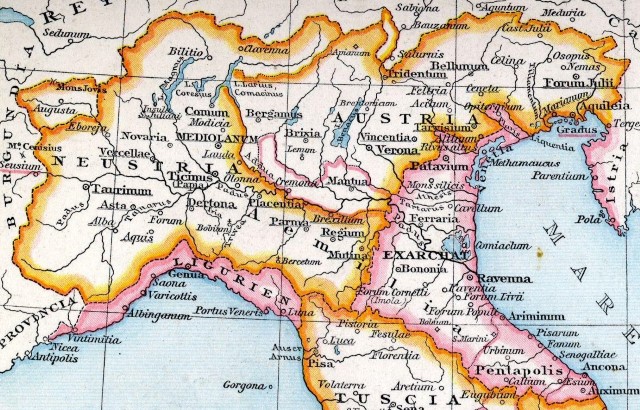
The Abbots Way is the modern name ascribed to an ancient medieval thoroughfare that linked Pavia to Pontremoli via staging posts such as Borgotaro and Borgallo – a distance of 195km. The route is marked by ancient and medieval structures, including towers, castles, fountains, chapels, and roads paved in stone. Originally monks’ cells, hospices, monasteries and properties of the order of St Columban were to be found at regular intervals.
The Abbots Way effectively became redundant with the Lombard conquest of the Exarchate of Ravenna in 751AD as this ended once and for all any Byzantine control of the Cisa Pass. These days the Way is used by hundreds of hikers, bikers and riders each year.
A detailed map and itinerary for the Way are for sale via the official web site and GPX files suitable for upload to a GPS are also available.
Further information is readily available – see for example the article in Italy Magazine.
St Columban
Columbanus (540 – 21 November 615), also known as St. Columban, was an Irish missionary notable for founding a number of monasteries from around 590 in the Frankish and Lombard kingdoms, most notably Luxeuil Abbey in present-day France and Bobbio Abbey in present-day Italy. He is remembered as a key figure in the Hiberno-Scottish mission, or Irish missionary activity in early medieval Europe.
Columbanus arrived in Milan in 612 and was warmly greeted by King Agilulf and Queen Theodelinda of the Lombards. He immediately began refuting the teachings of Arianism, which had enjoyed a degree of acceptance in Italy. He wrote a treatise against Arianism, which has since been lost. Queen Theodelinda, the devout daughter of Duke Garibald I of Bavaria, played an important role in restoring Nicene Christianity to a position of primacy against Arianism, and was largely responsible for the king’s conversion to Christianity.
King Agilulf gave Columbanus a tract of land called Bobbio between Milan and Genoa near the Trebbia river, situated in a defile of the Apennine Mountains, to be used as a base for the conversion of the Lombard people. The area contained a ruined church and wastelands known as Ebovium, which had formed part of the lands of the papacy prior to the Lombard invasion. Columbanus wanted this secluded place, for while enthusiastic in the instruction of the Lombards he preferred solitude for his monks and himself. Next to the little church, which was dedicated to Saint Peter, Columbanus erected a monastery in 614. Bobbio Abbey at its foundation followed the Rule of Saint Columbanus, based on the monastic practices of Celtic Christianity. For centuries it remained the stronghold of orthodoxy in northern Italy.
For further details see: https://en.wikipedia.org/wiki/Columbanus
Exarchate of Ravenna

The Exarchate of Ravenna or of Italy was a lordship of the Eastern Roman Empire today referred to by some as the Byzantine Empire in Italy, from 584 to 751, when the last exarch was put to death by the Lombards. It was one of two exarchates established following the western reconquests under Emperor Justinian to more effectively administer the territories, along with the Exarchate of Africa.